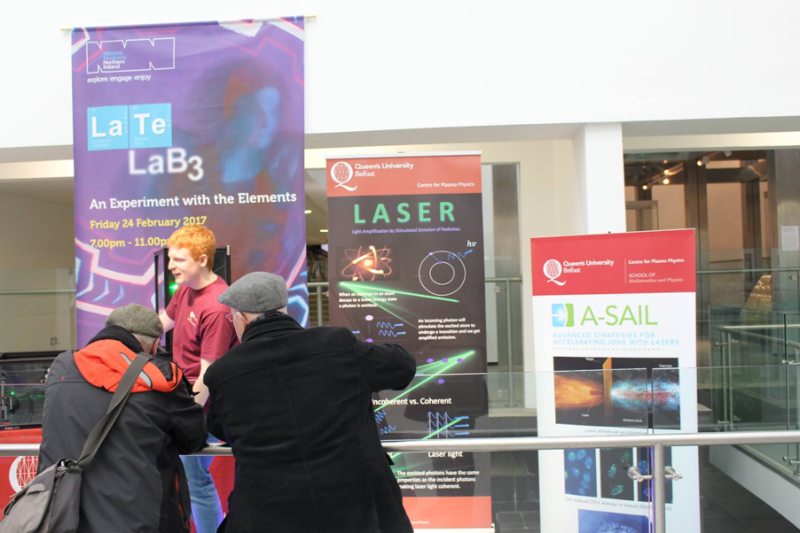Lasers Live
Since 2015, the Centre for Plasma Physics (CPP) has operated the Lasers Live outreach event to showcase its research in high power lasers and promote the public’s knowledge of light-based technologies. At the core of this underpinning research is the world-class TARANIS laser facility based in the School of Mathematics and Physics. Many of our researchers work in fields based around using such lasers to generate secondary radiation sources with unique properties such as ultrashort pulse ion beams and coherent X-rays. These have wide ranging uses including fundamental physics, studying astrophysical phenomena in the lab and even potential applications in life sciences.
Lasers Live is aimed at all age groups but with a particular focus on schools, both primary and secondary, and young adults. Its key aim is to get young people excited about Physics based subjects with the ultimate goal of increasing university applications in this area whilst also educating older age groups about this important science and raising awareness of the cutting age research taking place at Queen's University.

We achieve this through fun and interactive demonstrations, all guided and explained by our outstanding postgraduate research students and postdoctoral staff. Our highly visual and engaging displays include popping balloons with laser pens to explore the origin of colours and demonstrating the concept of polarisation using hidden images on a screen.
While we have primarily been based inside the nearby Ulster Museum during the annual Northern Ireland Science Festival, we have also taken our show on the road to present it at other venues including W5, the Cavan-Monaghan Science Festival and Dublin Maker.
Responses of over 1200 people gathered from kiosk style iPad surveys placed near the display showed a good demographic reach with a 57%:43% male/female split and respondents from all age ranges. The survey data also provides clear evidence of educational impact. When asked about specific physics concepts they had learned after interacting with us, 79% said they now knew why objects have the colour they do, 76% understood the difference between laser light and the light from a lightbulb and 72% learned how the concept of polarisation is important in technology such as LCD computer screens.
Lasers Live has also shown itself to be a very effective teaching tool for the communication of science to a non-specialist audience and public speaking for young scientists. We have direct evidence of the enhancement of communication skills for scientific concepts in an effective and concise conversational manner. Mark Coughlan won the poster prize at the 44th European Physical Society Conference on Plasma Physics in June 2016 in Leuven and was a finalist for the Institute of Physics poster prize in Feb 2016 in Belfast. Similarly, Hannah Donnelly won the poster prize at the High Energy Density Physics conference in Hirschegg in 2016, as did Nicole Breslin later in 2018 at the same conference. Each of these PhD students from CPP communicated their work to non-experts, to a prize-winning standard, in the same conversational manner that is used in Lasers Live.
EPSRC Grants:
EP/P016960/1 Ultrafast laser-driven ion interactions in matter: Evolving dose distribution at the nanoscale and nonlinear response
EP/P010059/1 Nanorad - Ultrafast, nano-scale material response to radiation and applications of ultrafast radiation sources.
